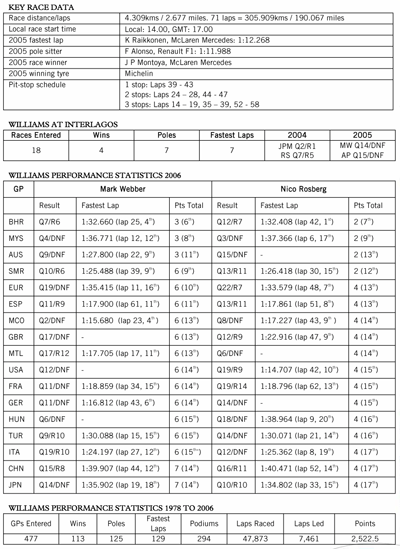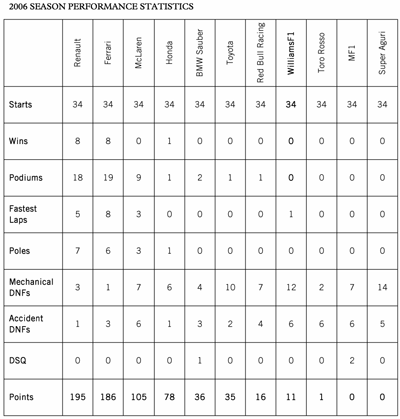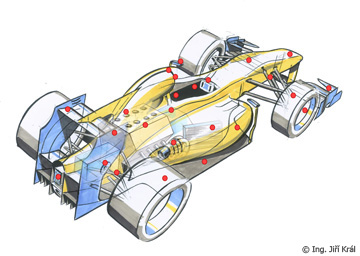Tiskov├Ī informace - WilliamsF1 (EN)
Miroslav Sanytr├Īk | 20.10.06 | Aktuality
PREVIEW BULLETIN
BRAZILIAN GRAND PRIX, 22 OCTOBER 2006
The Event
The 2007 Formula One World Championship makes its final stop of the season in South America this weekend for the 34th Brazilian Grand Prix. Situated on the outskirts of Sao Paulo, the Carlos Pace Autodromo is one of the most atmospheric race tracks visited all year and will provide a fitting backdrop for what will undoubtedly be an explosive season finale as Renault and Ferrari battle it out for Championship glory. Politics and finance have dictated InterlagosŌĆÖ chequered history since it opened in 1952, and were perhaps the primary cause behind its late debut on the Formula One calendar in 1973. WilliamsF1 has fielded 36 cars over the past 18 races at Interlagos, taking 40% of all poles and possible fastest laps and 22% of race wins. After a difficult year, the WilliamsF1 Team will be hoping for a positive end to the season to sustain motivation over a long winter programme of development.
Between the races
Immediately following Japan, Nico travelled to Bangkok to assist Oris with the launch of the Nico Rosberg Limited Edition mechanical racing watch. To reflect the 2,400 cylinder capacity of a V8 engine, only 2,400 watches will be issued worldwide. With all his commitments in the Far East completed, Nico headed to South America on Tuesday last week to give himself ample time to acclimatise and to spend a few days discovering Rio and working on his fitness levels. Mark returned to the UK after Japan to participate in a one day adventure race in Hampshire last weekend as part of his preparation for the forthcoming Mark Webber Pure Tasmania Challenge. Out of a 160-strong field, Mark and his three man team finished second. On Monday, he joined Australian rugby union star, Matt Burke, and Ally McCoist on the BBCŌĆÖs Question of Sport Ashes special.
Making the car go faster
Both FW28s will feature the same specification as that which was raced in both China and Japan. The team also completed a four day test session in Jerez, southern Spain, last week during which Alex Wurz and Narain Karthikeyan carried out a series of race distances to determine which of BridgestoneŌĆÖs tyre compounds will be best suited to Brazil.
Interlagos from a technical perspective
The 71 lap Brazilian Grand Prix will be a true test of durability for man and machine, heightened by the fact that the race is run in an anti-clockwise direction. The 4.3km circuit consists of 13 medium and slow speed corners, nine left and four right, and has a blend of long, fast straights and gradient changes. With such a varied layout, set-up compromises are inevitable, and the challenge lies in achieving optimal aerodynamic efficiency around the lap. Interlagos is a notoriously bumpy circuit, so not only is it draining on the drivers, but the cars must have a good mechanical balance for drivability. Combined with the bumps, the track is also particularly abrasive, so harder compound tyres must be selected to ensure their survival. Engines are also under intense pressure in Brazil, with the long straights demanding extensive periods at full throttle and high revs, while the high altitude and thinning air saps approximately 8% of overall power around the lap. Plenty of overtaking opportunities, combined with the areaŌĆÖs unpredictable weather conditions, will only enhance what is always an entertaining spectacle in Brazil.
|
Mark Webber
ŌĆ£ItŌĆÖs clear itŌĆÖs been a long and tough season for everyone at Williams but, with one event remaining, weŌĆÖll be doing our utmost to extract the best possible result from the package we have. Interlagos will mark my last race for the team and, of course, it would be nice to sign off with a strong result for the boys. All the focus, however, will be on the main fight for the Championship. It was fantastic to see Fernando win at Suzuka but, knowing Michael and Ferrari, they will continue to push until the end. As with the last two events in China and Japan, weather could still play a role in sealing the Championship as the Brazilian Grand Prix is often wet on at least one of the days. ThereŌĆÖs always a fantastic atmosphere at the track, the Brazilians are so passionate about Formula One and will be right behind their home drivers. Interlagos is a very unique circuit, itŌĆÖs a very bumpy and short lap and I expect the qualifying times to be incredibly close.ŌĆØ
Nico Rosberg
ŌĆ£Brazil seems to be a great place. I was in Rio for the week prior to the race in order to get used to the time difference from China and Japan, and it is an awesome city. I learnt to surf there, which was really good fun. The Interlagos track is again completely new for me so I"m going to need to learn it fast. I will probably be at the track on Wednesday to have a close look at it with our engineers. Performance-wise, itŌĆÖs important that we build on the progress that we made in Japan and I hope that the Bridgestone tyres are as strong in Brazil as they were in Suzuka.ŌĆØ
Sam Michael, Technical Director, WilliamsF1
ŌĆ£Interlagos is a great race track with plenty of overtaking opportunities, mainly created by the two straights and the variable gradients. Dominated by slow to medium corners and straight lines, it is important to have a good car balance in the corners that precede the straights. The long pitlane and low fuel penalty both have a first order affect on strategy decision and indeed what tyre compound level we will use. We worked with Bridgestone at last weekŌĆÖs Jerez test to select two tyres that will cover the varying track temperatures that we can experience in Brazil. This weekendŌĆÖs race, the final round of the Championship, will be significant for the team for two reasons. Firstly, it will be MarkŌĆÖs last before he leaves WilliamsF1. Mark has made a significant contribution over the past two seasons, not only on the race track, but he has also been a great team player and we wish him well for the future. It will also be CosworthŌĆÖs last race with Williams, and we thank them for all their efforts this year. For everyone involved with the team, it would be a fitting reward to take some points away from the final round. It hasnŌĆÖt been the best of years for us, but we have taken all the lessons learnt on reliability and performance and are busy applying them to our 2007 car, where we aim to return to being a front running team.ŌĆØ
Simon Corbyn, Head of F1 Race Engineering, Cosworth
ŌĆ£The 2006 Brazilian Grand Prix is likely to be the last race for Cosworth as a Formula One engine supplier. The objective from the outset of the CA2006 programme was to deliver the benchmark new generation V8 Formula One engine. Cosworth believe we achieved that in terms of engine performance, reliability and also engineering support to WilliamsF1.
Mark Webber will start the weekend with a fresh Series 6 engine and will run an engine duty cycle specifically for Brazil which will allow the engine to run at 20,000RPM for the entire race. Cosworth will be going all out to add to our tally of 176 wins in 39 seasons of Formula One.ŌĆØ
|






